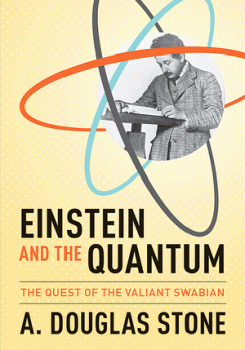Einstein’s Monster
An excerpt from “Einstein and the Quantum: The Quest of the Valient Swabian.”
The following is excerpted from Einstein and the Quantum: The Quest of the Valiant Swabian, by A. Douglas Stone
“Let’s see if Einstein can solve our problem.” This was not an idea I had ever entertained, much less verbalized, during my previous twenty-six years doing research in quantum physics. Physicists don’t read the works of the great masters of earlier generations. We learn physics from weighty textbooks in which the ideas are stated with cold-blooded logical inevitability, and the history that is mentioned is sanitized to eliminate the passions, egos, and human frailties of the great “natural philosophers.” After all, since physical science (we believe) is a cumulative discipline, why shouldn’t we downplay or even censor the missteps and misunderstandings of our predecessors? It is daunting enough to attempt to master and then extend the most complex concepts produced by the human mind, such as the bizarre description of the atomic world provided by quantum theory. Wouldn’t telling the real human history of discovery just confuse people?
The following is an excerpt from Einstein and the Quantum: The Quest of the Valiant Swabian, by A. Douglas Stone.
Thus, while I had studied history and philosophy of science avidly as an undergraduate, I had not read a single word written by Einstein during my actual career as a research physicist. I was of course aware that Einstein had contributed to the subject of quantum physics. Even freshman physics students learn that Einstein explained the photoelectric effect and said something fundamental about the quantized nature of light. And both atomic and solid-state physics (my specialty) have specific equations of quantum theory named for Einstein. So clearly the guy did something important in the subject. But the most familiar fact about Einstein and quantum mechanics is that he just didn’t like it. He refused to use the theory in its final form. And troubled by the fundamental indeterminism of quantum mechanics, he famously dismissed its worldview with the phrase “God does not play dice.”
Despite its esoteric-sounding name, quantum mechanics represents arguably the greatest achievement of human understanding of nature. By the end of the nineteenth century progress in physical science was stymied by the most basic problem: what are the fundamental constituents of matter, and how do they work? The existence of atoms was fairly well established, but they were clearly much too small to be observed in any direct manner. Hints were emerging from indirect probes that the microscopic world did not obey the settled laws of macroscopic Newtonian physics; but would scientists ever be able to understand and predict the properties of objects and forces so far from our everyday experience? For decades the answer was in doubt, until a theory emerged, a theory that has now withstood almost a century of tests and extensions. That theory has wrung human knowledge from the deep interior of the atomic nucleus and from the vacuum of intergalactic space. It is the theory that most physicists use every day in their work. This is the theory that Einstein rejected. Thus most physicists think of Einstein as playing a significant but still secondary role in this intellectual triumph.
I might have continued with this conventional view of Einstein and quantum physics for my entire career, if not for a coincidental intersection of my own research with that of the great man. I am interested in quantum systems, which if they were not microscopic but were scaled up in size to everyday proportions, would behave “chaotically.” In physics this is a technical term; it means that very small differences in the initial state of a system lead to large differences in the final state, similar to the way a pencil, momentarily balanced on its point, will fall to the left or right when nudged by the smallest puff of air. I was searching (with one of my PhD students) for a good explanation of the difficulty that arises when mixing this sort of unstable situation with quantum theory. I recalled hearing that Einstein had written something related to this in 1917 and, almost as a lark, I suggested that we see if this work were relevant to our task.

Well the joke was on us. When we finally got our hands on the paper, we quickly realized that Einstein had put his finger on the essence of the problem and had delineated when it has a solution, before the invention of the modern quantum theory. Moreover, Einstein wrote with great lucidity about the subject, so that it seemed as if he were speaking directly to us, a century later. There was nothing dated or quaint about the analysis. For the first time in a long while, I found myself thinking, “Wow, this man really was a genius.”
This experience piqued my interest in the actual history of Einstein and quantum theory, and as I delved into the subject I came to a stunning realization. It was Einstein who had introduced almost all the revolutionary ideas underlying quantum theory, and who saw first what these ideas meant. His ultimate rejection of quantum theory was akin to Dr. Frankenstein’s shunning of the monster he had originally created for the betterment of mankind. Had Einstein not done so, in all likelihood he would be seen as the father of the modern theory.
Excerpted from Einstein and the Quantum: The Quest of the Valiant Swabian, by A. Douglas Stone. (c) 2014 by Princeton University Press. Reprinted by permission.”
Douglas Stone is Deputy Director of the Yale Quantum Institute and the Carl A. Morse Professor of Applied Physics at Yale University in New Haven, Connecticut.